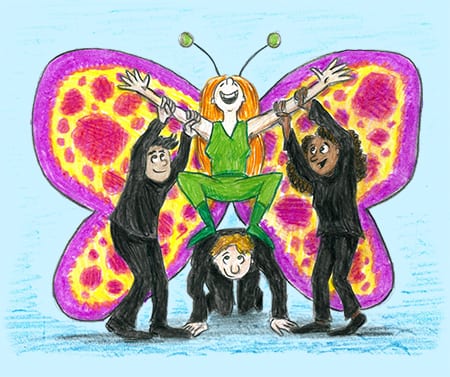 The most valuable creative experience I’ve ever had might be the time I needed to make someone fly.
The most valuable creative experience I’ve ever had might be the time I needed to make someone fly.
As a longtime playwright and theater director, I’ve had to tackle all sorts of self-imposed artistic challenges, generally with little to no budget. Every show that I’ve worked on has contained “that scene” – the one that drives you nuts until the very last minute. But, it usually ends up being the best one in the whole show, because you have to be more creative to pull it off.
Once, “that scene” called for an actor to fly – without ropes, pulleys or any kind of technical trickery. The show was more like a dance performance than a traditional play, a fictional creation myth about the dawn of civilization that required a showdown between the protagonist – a monkey on the road to humanity – and a deadly insect that enacts revenge after the monkey tries to squish it. (Yeah, it’s weird, just roll with it.)
Playing the bug was a petite dancer/actress who would be carried around by two other black-clad performers to simulate flight. It made perfect sense in my head, but however hard we tried, we just couldn’t make it work. It’s not easy to gracefully carry a full-grown adult through the air, no matter how small, so despite the combined efforts of our entire cast and crew, what was supposed to be a buoyant, exciting scene felt dismally earthbound – and suddenly, we only had three days before opening night.
I spent hours wracking my brain, trying to figure out what to do, but all of my ideas led to dead ends. We figured we just weren’t trying hard enough, so the actors decided to meet early one night to get some extra practice. I felt guilty that I couldn’t arrive on time to help them, but I hoped that the extra effort would lead to improvement.
When I showed up, I was unprepared for the jubilant mood in the room. “We figured it out!” they shouted. In short order, they showed me that the point wasn’t to keep the actress aloft the whole time – rather, by changing her from a flying bug to a leaping bug, she could bound above the stage with the support of the other performers, springing high into the air and appearing to defy gravity. And it was true – the effect was exciting and effortless.
And yet, for a moment, I hesitated. This wasn’t what I had imagined – I wanted something more literal. And just as galling, the solution wasn’t mine – I wasn’t the heroic genius, but the guy who said yes to someone else’s idea.
Fortunately, that moment passed, and we quickly worked to fit the leaping approach into our earlier work. “That scene” suddenly had the speed and energy it needed – and it turned out to be a highlight of the show.
I still think about what I learned that night, and use those lessons whenever I encounter a creative obstacle:
- Great ideas require you to keep your feet on the ground.
In a metaphor made literal, we couldn’t stay up in the air. The resistance and solidity of the floor gave us something to bounce off, creating the dynamic energy we were looking for. True creativity requires context – you can’t just float around untethered. It’s necessary to take stock and remind yourself what you’re working toward – to maintain contact with the ground you’re working from – and use that as a tool to propel you further.
- Great ideas come from trusting your collaborators.
Though I was “in charge” of this project, actually creating it was a group endeavor. If I had insisted on solving the problem on my own, it never would have happened. Sometimes we need a team to break through the limits of our individual minds and devise something bigger than we are.
- Great ideas require persistence.
We wouldn’t have hit on a solution if we hadn’t been working on the problem for weeks. We weren’t just spinning our wheels that whole time – we were building relationships and narrowing our options to prepare us for the eventual breakthrough.
- Great ideas mean letting go.
Was the scene that we produced the one that I had originally imagined? Nope. It was better than that – but it would never have happened if I’d become stuck in that moment of hesitation and refused to be flexible.
So if you ever need to fly, keep these lessons in mind, and hopefully you’ll find your own way to take off.